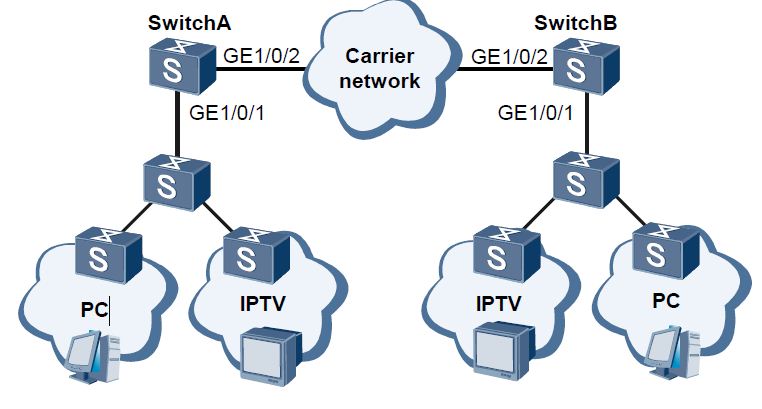How to Configure Selective QinQ in Huawei Switch:
Networking Requirements:
As shown in Figure, common Internet access users (using PCs) and IPTV users (using IPTV terminals) connect to the carrier network through Switch A and Switch B and communicate with each other through the carrier network. [boxads]
It is required that packets of PCs and IPTV terminals are tagged VLAN 2 and VLAN 3 when the packets are transmitted through the carrier network.

Configuration Roadmap:
The configuration roadmap is as follows:
1. Create VLANs on Switch A and Switch B.
2. Configure types of interfaces on Switch A and Switch B, and add the interfaces to corresponding VLANs.
3. Configure selective QinQ on interfaces of Switch A and Switch B.
[adsense]
Data Preparation:
To complete the configuration, you need the following data:
1. VLANs that PCs belong to: VLAN 100 to VLAN 200
2. VLANs that IPTV terminals belong to: VLAN 300 to VLAN 400
3. VLAN tag that packets of PCs carry on the carrier network: VLAN 2
4. VLAN tag that packets of IPTV terminals carry on the carrier network: VLAN 3
Configuration Procedure:
Step-1: Create VLANs.
# On Switch A, create VLAN 2 and VLAN 3, that is, the outer VLAN IDs added to packets on the carrier network.
<Quidway> system-view
[Quidway] sysname SwitchA
[SwitchA] vlan batch 2 3
# On Switch B, create VLAN 2 and VLAN 3, that is, the outer VLAN IDs added to packets on the carrier network.
<Quidway> system-view
[Quidway] sysname SwitchB
[SwitchB] vlan batch 2 3
Step-2: Configure selective QinQ on interfaces of Switch A and Switch B.
# Configure GE 1/0/1 of Switch A.
[SwitchA] interface gigabitethernet 1/0/1
[SwitchA-GigabitEthernet1/0/1] port link-type hybrid
[SwitchA-GigabitEthernet1/0/1] port hybrid untagged vlan 2 3
[SwitchA-GigabitEthernet1/0/1] port vlan-stacking vlan 100 to 200 stack-vlan 2
[SwitchA-GigabitEthernet1/0/1] port vlan-stacking vlan 300 to 400 stack-vlan 3
[SwitchA-GigabitEthernet1/0/1] quit
[bodyads]
# Configure GE 1/0/1 of Switch B.
[SwitchB] interface gigabitethernet 1/0/1
[SwitchB-GigabitEthernet1/0/1] port link-type hybrid
[SwitchB-GigabitEthernet1/0/1] port hybrid untagged vlan 2 3
[SwitchB-GigabitEthernet1/0/1] port vlan-stacking vlan 100 to 200 stack-vlan 2
[SwitchB-GigabitEthernet1/0/1] port vlan-stacking vlan 300 to 400 stack-vlan 3
[SwitchB-GigabitEthernet1/0/1] quit
Step-3: Configure other interfaces.
# Add GE 1/0/2 of Switch A to VLAN 2 and VLAN 3.
[SwitchA] interface gigabitethernet 1/0/2
[SwitchA-GigabitEthernet1/0/2] port link-type trunk
[SwitchA-GigabitEthernet1/0/2] port trunk allow-pass vlan 2 3
[SwitchA-GigabitEthernet1/0/2] quit
# Add GE 1/0/2 of Switch B to VLAN 2 and VLAN 3.
[SwitchB] interface gigabitethernet 1/0/2
[SwitchB-GigabitEthernet1/0/2] port link-type trunk
[SwitchB-GigabitEthernet1/0/2] port trunk allow-pass vlan 2 3
[SwitchB-GigabitEthernet1/0/2] quit
Step-4: Verify the configuration.
# View the configuration of each interface on Switch A.
<SwitchA> display current-configuration interface gigabitethernet 1/0/1
#
interface GigabitEthernet1/0/1
port hybrid untagged vlan 2 to 3
port vlan-stacking vlan 100 to 200 stack-vlan 2
port vlan-stacking vlan 300 to 400 stack-vlan 3
#
return
<SwitchA> display current-configuration interface gigabitethernet 1/0/2
#
interface GigabitEthernet1/0/2
port link-type trunk
port trunk allow-pass vlan 2 to 3
#
return
#View the configuration of each interface on Switch B.
<SwitchB> display current-configuration interface gigabitethernet 1/0/1
#
interface GigabitEthernet1/0/1
port hybrid untagged vlan 2 to 3
port vlan-stacking vlan 100 to 200 stack-vlan 2
port vlan-stacking vlan 300 to 400 stack-vlan 3
#
return
<SwitchB> display current-configuration interface gigabitethernet 1/0/2
#
interface GigabitEthernet1/0/2
port link-type trunk
port trunk allow-pass vlan 2 to 3
#
return
If Switch A and Switch B are configured correctly:
* PCs can communicate with each other through the carrier network.
* IPTV terminals can communicate with each other through the carrier network.
Configuration Files:
Only the configuration files of the Switches are provided:
#Configuration file of Switch A
#
sysname SwitchA
#
vlan batch 2 to 3
#
interface GigabitEthernet1/0/1
port hybrid untagged vlan 2 to 3
port vlan-stacking vlan 100 to 200 stack-vlan 2
port vlan-stacking vlan 300 to 400 stack-vlan 3
#
interface GigabitEthernet1/0/2
port link-type trunk
port trunk allow-pass vlan 2 to 3
#
return
# Configuration file of Switch B
#
sysname SwitchB
#
vlan batch 2 to 3
#
interface GigabitEthernet1/0/1
port hybrid untagged vlan 2 to 3
port vlan-stacking vlan 100 to 200 stack-vlan 2
port vlan-stacking vlan 300 to 400 stack-vlan 3
#
interface GigabitEthernet1/0/2
port link-type trunk
port trunk allow-pass vlan 2 to 3
#
return

